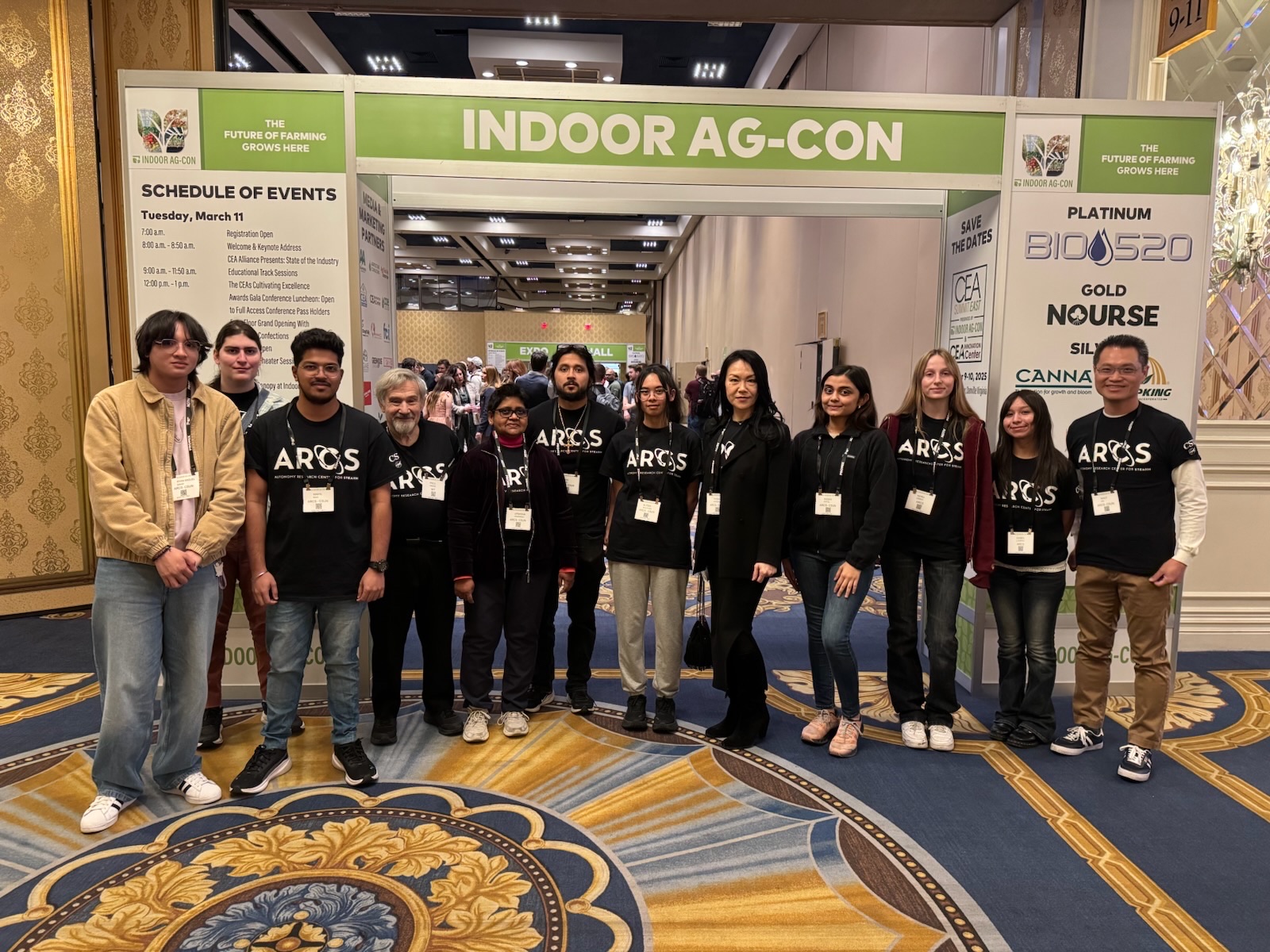Research Project
FOODI: Facilitating Overcoming Obstacles to the Development and Integration of Modern Technologies for Controlled Environment Agriculture (CEA)
Research Team
Lead Researcher:
- Dr. Nhut Ho, Director, ARCS, Mechanical Engineering
Mentor:
- Fred Gross, Senior Advisor, ARCS
Collaborators:
- Guillermo Herrera, Mechanical Engineering
- LAPD PALS Devonshire Youth Center
- LA Pierce College, Department of Agriculture
Student Team:
- Jade Dergevorkian, ARCS Fellow, MS Computer Science
- Farhan Darvish, BS Biotechnology
- Keira Ebner, Calabasas High School Senior
- Isabel Lucero, BS Computer Science
- Diego Machuca, BS Mechanical Engineering
- Alyssa Muldong, BS Computer Science
- Hao Phan, BS Mechanical Engineering
- Luis Arroyo Turcio, MS Manufacturing Systems Engineering & Management
- Nikhil Naik, MS Manufacturing Systems Engineering & Management
- Salman Sattar, BS Computer Science
SYNOPSIS
- This initiative aims to better understand and address the obstacles faced by companies that have started to CEA and then develop solutions to overcome those obstacles.
- Efforts have started to create “digital twins” to help educate students on using AI Technologies as well as provide support to the CEA industry.
- A small-scale hydroponic growing effort has been initiated to provide data for training models to educate students on data-driven autonomous systems.
- Efforts are underway to help stimulate a Southern California Hub for CEA by providing a skilled workforce through CSUN, local high schools, and LA Pierce College.
Abstract
Controlled Environment Agriculture (CEA) technologies provide numerous advantages over traditional agriculture, particularly considering climate trends that have altered the suitability of land for cultivation. CEA offers more sustainable food production with significantly reduced water, nutrients, and land usage, and enables food production closer to population centers in various climates. Additionally, CEA is more amenable to automation compared to traditional farming methods. Despite some successes in recent years, many CEA facilities have failed, including those with substantial investments and initial market presence. The objective of this project is to continue to analyze the obstacles limiting the growth of the CEA industry and understand the factors contributing to both the success and failure of commercial ventures. The project will work to develop and implement solutions and build tools to help overcome these challenges.
Motivation/Research Problem
Many nations face growing food insecurity issues, which are exacerbated by threats to agricultural areas from competing land uses, water shortages, climate change, and rising costs of labor, equipment, and materials. Collectively, these issues represent an existential threat to the California economy. CEA has the potential to address these challenges; however, its technology remains underdeveloped and faces numerous obstacles that have led to the failure of many CEA farms and significant investment losses. This research seeks to identify and clarify these obstacles and propose viable solutions.

Research Questions and Research Objectives
- What are the nature and extent of obstacles hindering the growth and stability of CEA farms?
- What is needed to support the growth of CEA in California?
- How can we analyze the use of technology in CEA farms?
- How can technology be improved to reduce the costs of CEA farms?
- How can education and training be enhanced to overcome the shortage of skilled personnel for managing, operating, and maintaining CEA farms?
Research Methods
-
Understand CEA technology
-
Understand the CEA industry
-
Case studies of successes and failures
-
Solicit support for research and education
-
Build partnerships with industry, governments, and other educational institutions to implement solutions
Research Results and Deliverables
-
A paper on obstacles to the implementation of CEA technology based on contributions from all team members will be prepared along with an annotated bibliography.
-
Case studies conducted by individual students.
Commercialization Opportunities
-
Digital twins of CEA facilities could be marketed as analytical tools to entrepreneurs or consulting firms specializing in technology integration.
-
Improved designs and equipment resulting from identified solutions could be licensed or sold to companies supplying CEA farms.
-
Students working on this initiative can initiate or join start-up companies to use CEA or help other companies use CEA.
Research Timeline
Summer 2025
-
Publish a paper on obstacles to the implementation of CEA technology and related solutions based on completed work.
-
Start growing microgreens and leafy greens in a vertical farm at LAPD PALS.
-
Build a prototype system for data collection in a hydroponic farm.
-
Begin development of a digital twin of microgreen growth that can learn from data with changing environmental variables.
-
Develop proposals to fund research to address documented obstacles.
Fall Semester 2025
-
Market proposals for projects based on solutions.
-
Create digital twins of plant growth and cultivation systems.
-
Form teams for funded projects.
Lead Researcher:
- Dr. Nhut Ho, Director, ARCS, Mechanical Engineering
Mentor:
- Fred Gross, Senior Advisor, ARCS
Collaborators:
- Guillermo Herrera, Mechanical Engineering
- LAPD PALS Devonshire Youth Center
- LA Pierce College, Department of Agriculture
Student Team:
- Jade Dergevorkian, ARCS Fellow, MS Computer Science
- Farhan Darvish, BS Biotechnology
- Keira Ebner, Calabasas High School Senior
- Isabel Lucero, BS Computer Science
- Diego Machuca, BS Mechanical Engineering
- Alyssa Muldong, BS Computer Science
- Hao Phan, BS Mechanical Engineering
- Luis Arroyo Turcio, MS Manufacturing Systems Engineering & Management
- Nikhil Naik, MS Manufacturing Systems Engineering & Management
- Salman Sattar, BS Computer Science
